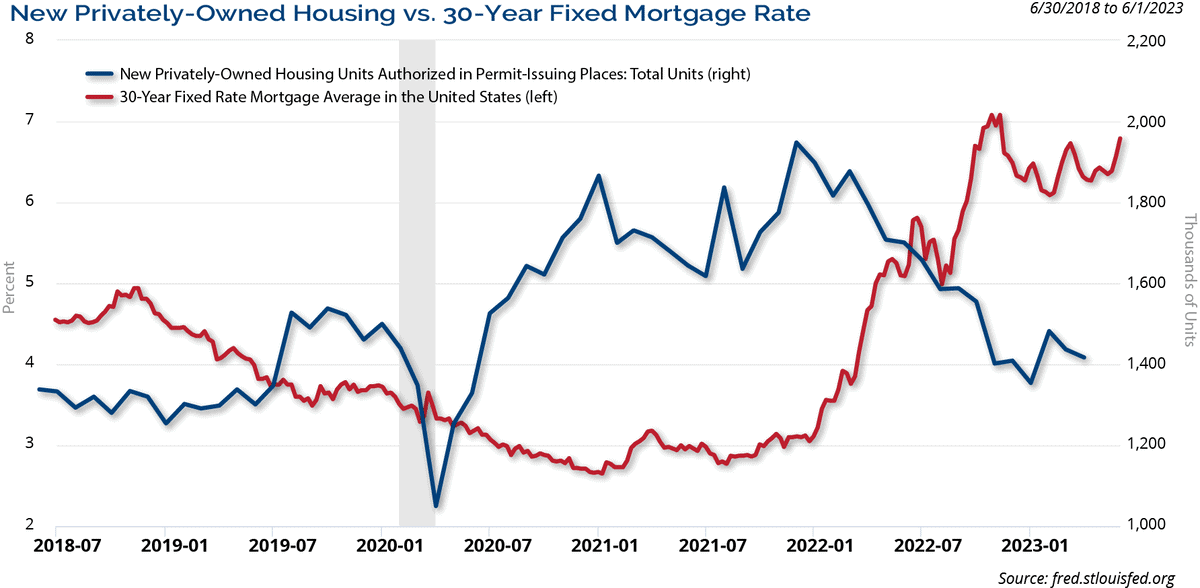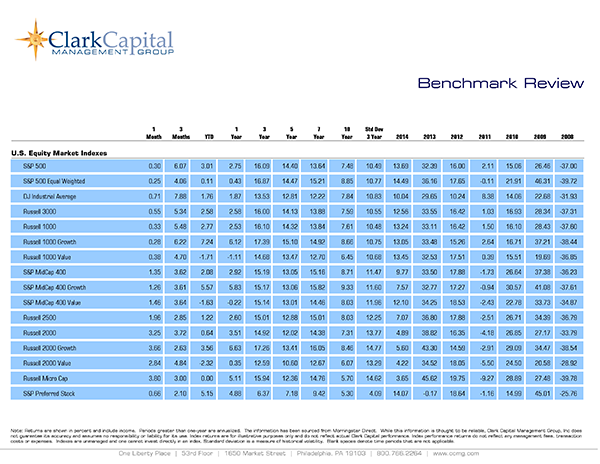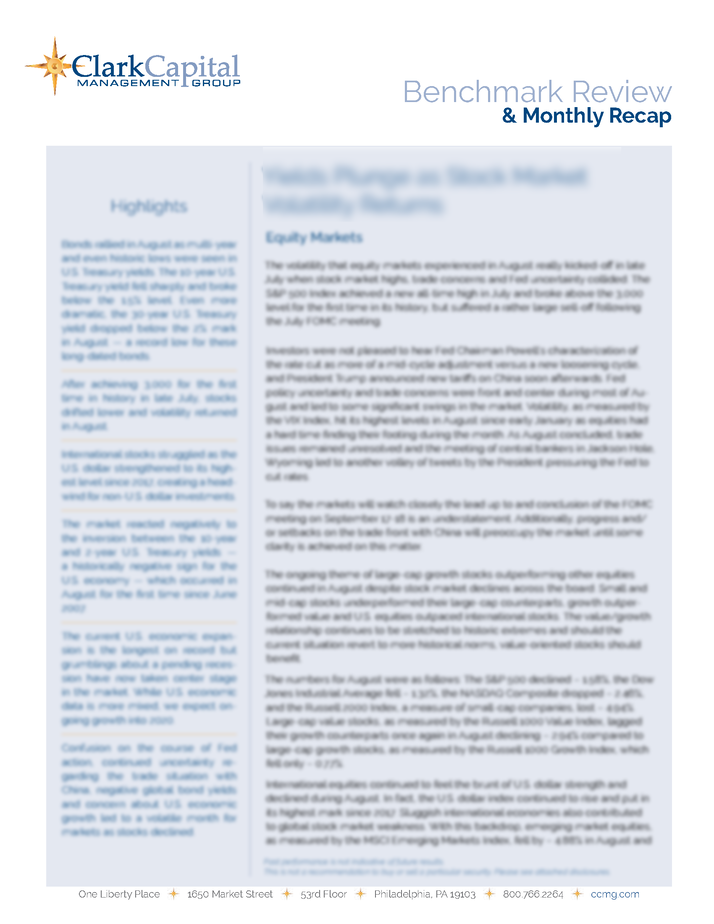Large Growth Rally Masks Broader Stock Market Weakness
HIGHLIGHTS:
- Equity gains focused on large-cap U.S. growth companies in May. However, the average stock was down for the month as were international equities.
- The VIX Index, a measure of stock market volatility, continued to be subdued in May. After closing April at 15.78 – a 52-week low – the VIX ticked lower to start May before closing the month at 17.94.
- The yield on the 10-year U.S. Treasury closed April at 3.44%, but it ended May higher at 3.64%. The yield had risen to over 3.8% in late May before declining rather sharply over the last few days of the month.
- Rising rates put bond returns under pressure in May. Although bonds declined for the month, most fixed income sectors remained positive year to date.
- The job market remained resilient as the unemployment rate dropped to 3.4%, matching the lowest level since 1969. However, manufacturing continued to contract and, while the service sector grew, the pace of growth slowed for the last two months.
EQUITY MARKETS
Large-cap growth companies resumed their recent leadership with solid gains in May. However, those results masked how stocks on average performed for the month and year to date. See Table 1 for equity results for May and year to date.
Table 1
| Index | May 2023 | YTD 2023 |
|---|---|---|
| S&P 500 | 0.43% | 9.65% |
| S&P 500 Equal Weight | -3.79% | -0.63% |
| DJIA | 3.17% | 0.25% |
| Russell 3000 | 0.39% | 8.74% |
| NASDAQ Comp. | 5.93% | 24.06% |
| Russell 2000 | -0.92% | -0.04% |
| MSCI ACWI ex U.S. | -3.64% | 4.77% |
| MSCI Emerging Mkts Net | -1.68% | 1.05% |
The S&P 500 Index was able to post a modest gain in May of 0.43%, but the average stock was down -3.79% during the month when looking at the S&P 500 on an equal-weighted basis. Recall the S&P 500 Index is a market-cap weighted index and is becoming more and more dominated by mega-cap Technology companies. Those mega-cap Technology companies have enjoyed a strong recovery from their 2022 declines, but the average stock is actually down year to date.
The tech-heavy NASDAQ Composite punctuates this point with a strong gain for the month of 5.93% and by far the best results of the equity indices with a year-to-date gain of 24.06%. Meanwhile, the Russell 2000 Index, a measure of small-cap companies, slipped into modestly negative year-to-date territory with a monthly decline of -0.92% in May.
On a year-to-date basis, significant divergences exist in the stock market. Large-cap growth stocks have been the clear winner so far in 2023. The action of the Russell 1000 Index epitomizes this disparity – the Russell 1000 Growth Index gained 20.76%, the Russell 1000 Value Index declined -1.43%, which puts the overall Russell 1000 Index at a gain of 9.30% year to date. Value has struggled compared to growth in 2023. International stocks, particularly in developed markets, have enjoyed solid year-to-date results, but some of the progress was given up with declines in May.
Fixed Income
Yields have been on a roller coaster ride so far in 2023 and that ride continued in May. In January, yields dropped rather sharply, but February saw yields rise dramatically as some inflation readings were “hot” and concern built the Fed might need to raise rates even higher than previously expected.
Equally as dramatic was the drop again in yields in March as there was a flight to quality with concerns about some regional banks. While April was somewhat calm, yields rose rather sharply in May once again before a late month drop. The 10-year U.S. Treasury closed April at 3.44% but rose to 3.64% by the close of May. May 25th saw the highest closing yield level for the month at 3.83%, but yields dropped sharply over the final few trading days of the month. Rates rose across the yield curve in May, which pushed bond prices lower. See Table 2 for fixed income index returns for May and year to date.
Table 2
| Index | May 2023 | YTD 2023 |
|---|---|---|
| Bloomberg U.S. Agg | -1.09% | 2.46% |
| Bloomberg U.S. Credit | -1.39% | 2.81% |
| Bloomberg U.S. High Yield | -0.92% | 3.64% |
| Bloomberg Muni | -0.87% | 1.65% |
| Bloomberg 30-year U.S. TSY | -2.72% | 3.27% |
| Bloomberg U.S. TSY | -1.16% | 2.35% |
We continue to expect the 10-year yield to move lower as we go through 2023, but we also anticipate volatility along the way. Rates moving lower, but with accompanying volatility, has largely occurred so far in 2023. It has clearly been a better environment for bonds in 2023 compared to 2022 even with the modest May pull back.
In previous Fed rate hike cycles, longer rates have started to come down before the Fed has stopped raising the Federal Funds rate and that pattern has played out this year as well. We maintain our opinion that we are in the late innings of this rate hike cycle. We also maintain our long-standing position favoring credit versus pure rate exposure in this interest rate environment. Finally, we believe the role bonds play in a portfolio, to provide stable cash flows and to help offset the volatility of stocks in the long run, has not changed.
Economic Data and Outlook
Based on the second reading of Q1 2023 GDP, the U.S. economy expanded faster than previously estimated at a 1.3% annualized pace in the first quarter compared the prior reading of 1.1%. Although this was slower than the expansion enjoyed in the second half of 2022, it was growth nonetheless. We expect economic growth to slow down later in the year and we acknowledge the risk of a mild recession has increased. We also believe the risk of recession is about as likely as a soft landing.
The second quarter began by reflecting continued strength in the job market. The unemployment rate ticked lower to 3.4% in April, beating expectations of 3.6% and the prior month’s reading of 3.5%. This matched the lowest unemployment level since 1969. Although the job market remains tight, job openings, based on the JOLTS reading, have been trending lower in recent months. This could signal a slowdown in the hiring appetite for businesses. Chart 1 shows the unemployment rate at a generational low of 3.4%, but also job openings trending lower over the last several months.
Chart 1.
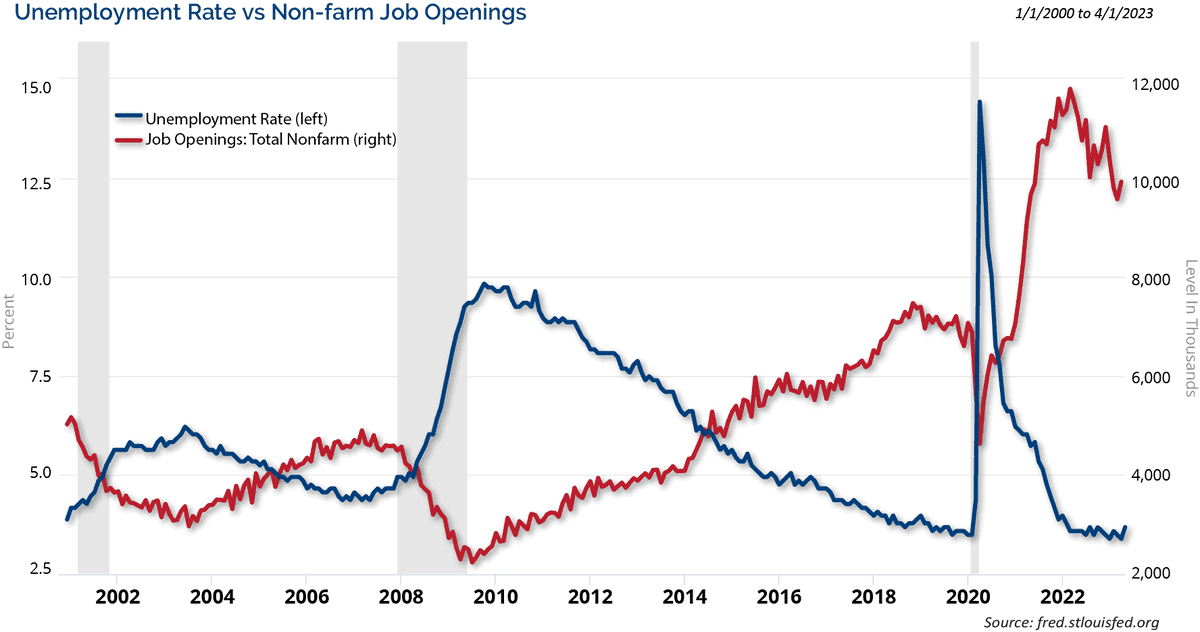
For illustrative purposes only. For illustrative purposes only. Past performance is not indicative of future results. Projections or other forward looking statements regarding future financial performance of markets are only predictions and actual events or results may differ materially.
The mismatch between job seekers and job openings still shows millions more open jobs available than people looking for work. Businesses might be slowing their hiring activity with concerns about potential weaker economic conditions, but that has not yet resulted in large-scale layoffs (with a few exceptions in the tech sector) or a move higher in the unemployment rate. At this point, businesses seem willing to hold on to workers rather than lay off staff, especially if there is an expectation that they might ultimately need to hire more people down the line.
Wages climbed by 4.4% on an annual basis in April, which was above expectations of 4.2%, and higher than the 4.3% gain in March. The Fed aggressively raising rates over the last year is expected to increase unemployment, but Fed rate hikes so far have not resulted in significant weakness in the job market outside of the tech sector. Too much strength in job market data could be viewed as inflationary by Fed officials and extend this period of restrictive monetary policy. We will watch developments in the job market closely with consumer spending accounting for about 70% of U.S. economic activity.
Housing continues to be impacted by higher interest rates due to mortgage rates rising as well. Building permits, considered a leading indicator for housing, missed expectations, and dropped lower in April to a 1.416 million annual pace. This pace is clearly slower than the over 1.9 million seen in December of 2021, just a few months before the first rate hike by the Fed. There is a negative correlation between higher mortgage rates and building permits. Chart 2 reflects this relationship, but as mortgage rates have recently plateaued, building permits seem to be stabilizing around the 1.4 million annual rate range as well.
Chart 2.
Housing starts were virtually in-line with estimates (1.401 million versus expectations of 1.400 million) and this was an improvement from the prior reading of 1.371 million, which had been revised significantly lower compared to the initial estimate of 1.420 million. Existing home sales missed expectations and were lower than March’s level, however new home sales surpassed estimates and improved from the prior month.
Housing prices reflected a drop in prices from March 2022 to March of 2023 by a little more than -1.1% based on the S&P CoreLogic CS 20-City Index for March – the first annual decline in more than a decade for this reading. The housing market will continue to be sensitive to changes in interest rates, but we believe the fundamentals in housing remain strong and the slowdown so far has been reasonable considering the move higher in mortgage rates. Supply still seems to be tight, which has largely supported home price levels.
The ISM Manufacturing Index showed contraction for the 6th consecutive month in April with a reading of 47.1. However, this was modestly better than expectations of 46.8 and it marked an improvement from the prior reading of 46.3, which had been the lowest level since May 2020. The ISM Non-Manufacturing Index, which covers the much larger service industries in the U.S. economy, improved to 51.9 compared to the previous reading of 51.2 and was a modest beat of expectations of 51.8. The service index has slowed in recent months, but it continues to be above 50, the dividing line between expansion and contraction for the ISM readings.
Retail sales (ex. auto and gas) rose more than expected by 0.6% in April, three times the estimated gain of 0.2%. This follows a drop in the prior month that was larger (-0.5%) than previously reported (-0.3%). The preliminary University of Michigan Sentiment reading for May slumped to 57.7 from 63.5 and was lower than expectations of 63.0. The debt-ceiling debate and ongoing issues with some regional banks likely hurt confidence during the early part of the month. The Conference Board’s Leading Index continued to decline and fell by -0.6% in April as expected.
Inflation readings were somewhat mixed, but largely in-line with expectations for April. The headline Consumer Price Index for April dropped to a 4.9% annual increase, modestly better than expectations and the prior month’s level of 5.0%. The core CPI was 5.5%, which matched expectations and was a 0.1% improvement from March. The headline Producer Price Index fell to a 2.3% annual increase, better than expectations of 2.5% and the prior month’s mark of 2.7%. The core PPI was 3.2%, modestly better than expectations of 3.3% and better than the 3.4% increase from March.
The Producer Price Index is generally seen as a leading indicator for inflation since these costs occur during the production part of the cycle before products are sold to consumers. However, the Fed’s preferred measure of inflation, the Personal Consumption Expenditures Index, rose to a 4.4% annual gain in April from the 4.2% level in March, and this was higher than expectations of 4.3%.
The core PCE reading was a 4.7% annual rise, modestly higher than expectations and the prior month’s mark of 4.6%. Overall, it seems clear that the trajectory for inflation is lower and we expect inflation to continue this trend through 2023. Chart 3 shows the percent change from a year ago for these headline inflation readings.
Chart 3.
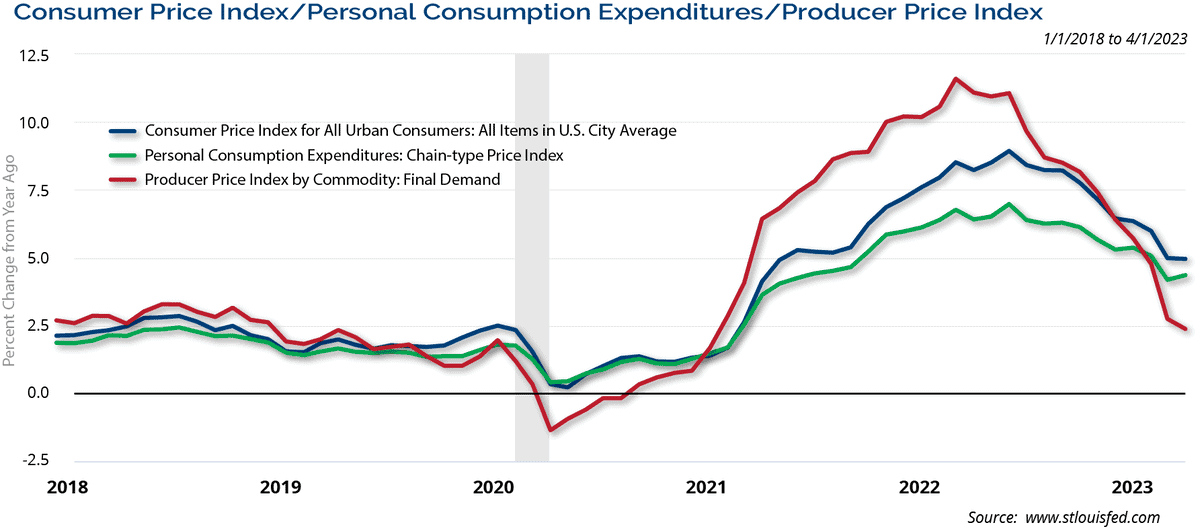
For illustrative purposes only. Past performance is not indicative of future results.
These inflation readings likely give the Fed cover either way for the upcoming FOMC meeting in June. If the Fed is inclined to raise rates again, it can point to continued readings above its policy goals. If the Fed decides to pause, it can point to inflation levels that seem to be on a clear trend lower. The market will watch the Fed’s decision closely in June for insight on the Fed’s path of monetary policy and rate changes going forward.
The market is still adjusting to the impact of the rate increases that began in March 2022. As the economy remains resilient, the Fed rate hike cycle might last longer than many had expected. Although economic growth picked up in the second half of 2022 and we believe that momentum continued early in the new year, we expect growth to slow later in 2023 and believe the odds of a mild recession are about 50/50.
The job market has remained resilient, which leads us to the conclusion that any economic slowdown would be modest. However, the recent slowdown in job openings might be an initial sign of more caution by employers in hiring with an expected weaker economic backdrop later in 2023. As always, we believe it is imperative for investors to stay focused on their long-term goals and not let short-term swings in the market derail them from their longer-term objectives.
Investment Implications
Clark Capital’s Top-Down, Quantitative Strategies
Our credit-based risk management models have maintained their risk-on bias, which has kept our tactical models overweight in equity and credit. The strength to date in the markets has been focused in large-cap growth and Technology, while defensive and value oriented sectors have lagged. As a result, the Style Opportunity portfolio is overweight large-cap growth with the remainder of the portfolio indexed to the S&P 500 itself.
Clark Capital’s Bottom-Up, Fundamental Strategies
The Q1 earnings season is mostly complete, with results outpacing pre-season forecasts. According to FactSet, the blended earnings per share (EPS) growth rate for S&P 500 constituents stands at 2.1%, well ahead of the 6.7% expected at the end of the quarter. The proportion of companies posting earnings and revenue beats has been above both the one and five-year averages, with the magnitude of earnings beats also outstripping the latest trends.
ECONOMIC DATA
| Event | Period | Estimate | Actual | Prior | Revised |
|---|---|---|---|---|---|
| ISM Manufacturing | Apr | 46.8 | 47.1 | 46.3 | — |
| ISM Services Index | Apr | 51.8 | 51.9 | 51.2 | — |
| Change in Nonfarm Payrolls | Apr | 185k | 253k | 236k | 165k |
| Unemployment Rate | Apr | 3.60% | 3.40% | 3.50% | — |
| Average Hourly Earnings YoY | Apr | 4.20% | 4.40% | 4.20% | 4.30% |
| JOLTS Job Openings | Mar | 9736k | 9590k | 9931k | 9974k |
| PPI Final Demand MoM | Apr | 0.30% | 0.20% | -0.50% | -0.40% |
| PPI Final Demand YoY | Apr | 2.50% | 2.30% | 2.70% | — |
| PPI Ex Food and Energy MoM | Apr | 0.20% | 0.20% | -0.10% | 0.00% |
| PPI Ex Food and Energy YoY | Apr | 3.30% | 3.20% | 3.40% | — |
| CPI MoM | Apr | 0.40% | 0.40% | 0.10% | — |
| CPI YoY | Apr | 5.00% | 4.90% | 5.00% | — |
| CPI Ex Food and Energy MoM | Apr | 0.40% | 0.40% | 0.40% | — |
| CPI Ex Food and Energy YoY | Apr | 5.50% | 5.50% | 5.60% | — |
| Retail Sales Ex Auto and Gas | Apr | 0.20% | 0.60% | -0.30% | -0.50% |
| Industrial Production MoM | Apr | 0.00% | 0.50% | 0.40% | 0.00% |
| Building Permits | Apr | 1430k | 1416k | 1413k | 1437k |
| Housing Starts | Apr | 1400k | 1401k | 1420k | 1371k |
| New Home Sales | Apr | 665k | 683k | 683k | 656k |
| Existing Home Sales | Apr | 4.30m | 4.28m | 4.44m | 4.43m |
| Leading Index | Apr | -0.60% | -0.60% | -1.20% | — |
| Durable Goods Orders | Apr P | -1.00% | 1.10% | 3.20% | 3.30% |
| GDP Annualized QoQ | 1Q S | 1.10% | 1.30% | 1.10% | — |
| U. of Mich. Sentiment | May P | 63 | 57.7 | 63.5 | — |
| Personal Income | Apr | 0.40% | 0.40% | 0.30% | — |
| Personal Spending | Apr | 0.50% | 0.80% | 0.00% | 0.10% |
| S&P CoreLogic CS 20-City YoY NSA | Mar | -1.60% | -1.15% | 0.36% | — |
Source: Bloomberg
Past performance is not indicative of future results. The opinions referenced are as of the date of publication and are subject to change due to changes in the market or economic conditions and may not necessarily come to pass. Material presented has been derived from sources considered to be reliable and has not been independently verified by us or our personnel. Nothing herein should be construed as a solicitation, recommendation or an offer to buy, sell or hold any securities, other investments or to adopt any investment strategy or strategies. Investors must make their own decisions based on their specific investment objectives and financial circumstances. Investing involves risk, including loss of principal.
Clark Capital Management Group is an investment adviser registered with the U.S. Securities and Exchange Commission. Registration does not imply a certain level of skill or training. More information about Clark Capital Management Group’s advisory services can be found in its Form ADV which is available upon request.
Fixed income securities are subject to certain risks including, but not limited to: interest rate (changes in interest rates may cause a decline in market value or an investment), credit, prepayment, call (some bonds allow the issuer to call a bond for redemption before it matures), and extension (principal repayments may not occur as quickly as anticipated, causing the expected maturity of a security to increase).
Clark Capital utilizes a proprietary investment model to assist with the construction of the strategy and to assist with making investment decisions. Investments selected using this process may perform differently than expected as a result of the factors used in the model, the weight placed on each factor, and changes from the factors’ historical trends. There is no guarantee that Clark Capital’s use of a model will result in effective investment decisions.
Non-investment-grade debt securities (high-yield/junk bonds) may be subject to greater market fluctuations, risk of default or loss of income and principal than higher-rated securities.
Foreign securities are more volatile, harder to price and less liquid than U.S. securities. They are subject to different accounting and regulatory standards and political and economic risks. These risks are enhanced in emerging market countries.
The value of investments, and the income from them, can go down as well as up and you may get back less than the amount invested.
Equity securities are subject to price fluctuation and possible loss of principal. Stock markets tend to move in cycles, with periods of rising prices and periods of falling prices. Certain investment strategies tend to increase the total risk of an investment (relative to the broader market). Strategies that concentrate their investments in limited sectors are more vulnerable to adverse market, economic, regulatory, political, or other developments affecting those sectors.
JOLTS is a monthly report by the Bureau of Labor Statistics (BLS) of the U.S. Department of Labor counting job vacancies and separations, including the number of workers voluntarily quitting employment.
The Producer Price Index (PPI) program measures the average change over time in the selling prices received by domestic producers for their output. The prices included in the PPI are from the first commercial transaction for many products and some services.
References to market or composite indices, benchmarks or other measures of relative market performance over a specified period of time (each, an “index”) are provided for your information only. Reference to an index does not imply that the portfolio will achieve returns, volatility or other results similar to that index. The composition of the index may not reflect the manner in which a portfolio is constructed in relation to expected or achieved returns, portfolio guidelines, restrictions, sectors, correlations, concentrations, volatility or tracking error targets, all of which are subject to change. Investors cannot invest directly in an index.
The Bloomberg Barclays U.S. Municipal Index covers the USD-denominated long-term tax exempt bond market. The index has four main sectors: state and local general obligation bonds, revenue bonds, insured bonds and prerefunded bonds.
The Bloomberg US Treasury Index measures US dollar-denominated, fixed-rate, nominal debt issued by the US Treasury. Treasury bills are excluded by the maturity constraint, but are part of a separate Short Treasury Index.
The Dow Jones Industrial Average indicates the value of 30 large, publicly owned companies based in the United States.
The NASDAQ Composite is a stock market index of the common stocks and similar securities listed on the NASDAQ stock market.
The S&P 500 measures the performance of the 500 leading companies in leading industries of the U.S. economy, capturing 80% of U.S. equities.
The S&P 500® Equal Weight Index (EWI) is the equal-weight version of the widely-used S&P 500. The index includes the same constituents as the capitalization weighted S&P 500, but each company in the S&P 500 EWI is allocated a fixed weight – or 0.2% of the index total at each quarterly rebalance.
The University of Michigan Consumer Sentiment Index rates the relative level of current and future economic conditions. There are two versions of this data released two weeks apart, preliminary and revised. The preliminary data tends to have a greater impact. The reading is compiled from a survey of around 500 consumers.
The Russell 1000 Growth Index measures the performance of the large-cap growth segment of the U.S. equity universe. It includes those Russell 1000 Index companies with higher price-to-book ratios and higher forecasted growth values.
The Russell 1000 Value Index measures the performance of the large-cap value segment of the U.S. equity universe. It includes those Russell 1000 Index companies with lower price-to-book ratios and lower forecasted growth values.
The Russell 2000 Index is a small-cap stock market index that represents the bottom 2,000 stocks in the Russell 3000.
The Russell 3000 Index measures the performance of the 3,000 largest U.S. companies based on total market capitalization, which represents approximately 98% of the investable U.S. equity market.
The 10 Year Treasury Rate is the yield received for investing in a US government issued treasury security that has a maturity of 10 year. The 10 year treasury yield is included on the longer end of the yield curve. Many analysts will use the 10 year yield as the “risk free” rate when valuing the markets or an individual security.
The Bloomberg Barclays U.S. Corporate High-Yield Index covers the U.S. dollar-denominated, non-investment grade, fixed-rate, taxable corporate bond market. Securities are classified as high-yield if the middle rating of Moody’s, Fitch, and S&P is Ba1/BB+/BB+ or below.
The Bloomberg Barclays U.S. Credit Index measures the investment grade, U.S. dollar denominated, fixed-rate taxable corporate and government related bond markets.
The Bloomberg Aggregate Bond Index or “the Agg” is a broad-based fixed-income index used by bond traders and the managers of mutual funds and exchange-traded funds (ETFs) as a benchmark to measure their relative performance.
The 30-Year Treasury is a U.S. Treasury debt obligation that has a maturity of 30 years. The 30-year Treasury used to be the bellwether U.S. bond but now most consider the 10-year Treasury to be the benchmark.
The ISM Non-Manufacturing Index is an index based on surveys of more than 400 non-manufacturing firms’ purchasing and supply executives, within 60 sectors across the nation, by the Institute of Supply Management (ISM). The ISM Non-Manufacturing Index tracks economic data, like the ISM Non-Manufacturing Business Activity Index. A composite diffusion index is created based on the data from these surveys, that monitors economic conditions of the nation.
ISM Manufacturing Index measures manufacturing activity based on a monthly survey, conducted by Institute for Supply Management (ISM), of purchasing managers at more than 300 manufacturing firms.
The MSCI Emerging Markets Index captures large and mid cap representation across 27 Emerging Markets (EM) countries.
The MSCI ACWI ex USA Index captures large and mid cap representation across 22 of 23 Developed Markets (DM) countries (excluding the US) and 27 Emerging Markets (EM) countries*. With 2,359 constituents, the index covers approximately 85% of the global equity opportunity set outside the US
The S&P CoreLogic Case-Shiller 20-City Composite Home Price NSA Index seeks to measures the value of residential real estate in 20 major U.S. metropolitan areas. The U.S. Treasury index is based on the recent auctions of U.S. Treasury bills. Occasionally it is based on the U.S. Treasury’s daily yield curve.
The Consumer Price Index (CPI) measures the change in prices paid by consumers for goods and services. The CPI reflects spending patterns for each of two population groups: all urban consumers and urban wage earners and clerical workers.
In the United States, the Core Personal Consumption Expenditure Price (CPE) Index provides a measure of the prices paid by people for domestic purchases of goods and services, excluding the prices of food and energy.
The VIX Index is a calculation designed to produce a measure of constant, 30-day expected volatility of the U.S. stock market, derived from real-time, mid-quote prices of S&P 500® Index (SPX℠) call and put options. On a global basis, it is one of the most recognized measures of volatility — widely reported by financial media and closely followed by a variety of market participants as a daily market indicator.
The Conference Board’s Leading Indexes are the key elements in an analytic system designed to signal peaks and troughs in the business cycle. The leading, coincident, and lagging economic indexes are essentially composite averages of several individual leading, coincident, or lagging indicators. They are constructed to summarize and reveal common turning point patterns in economic data in a clearer and more convincing manner than any individual component – primarily because they smooth out some of the volatility of individual components.
Gross domestic product (GDP) is the standard measure of the value added created through the production of goods and services in a country during a certain period.
Index returns include the reinvestment of income and dividends. The returns for these unmanaged indexes do not include any transaction costs, management fees or other costs. It is not possible to make an investment directly in any index.
CCM-993
